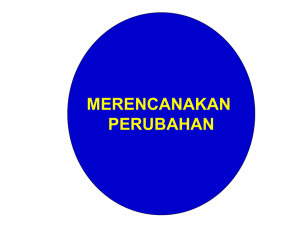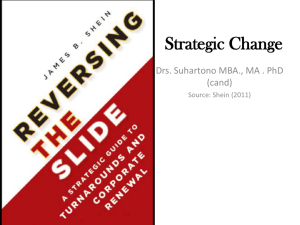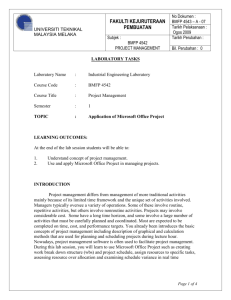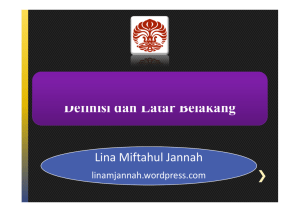Manajemen perubahan
advertisement
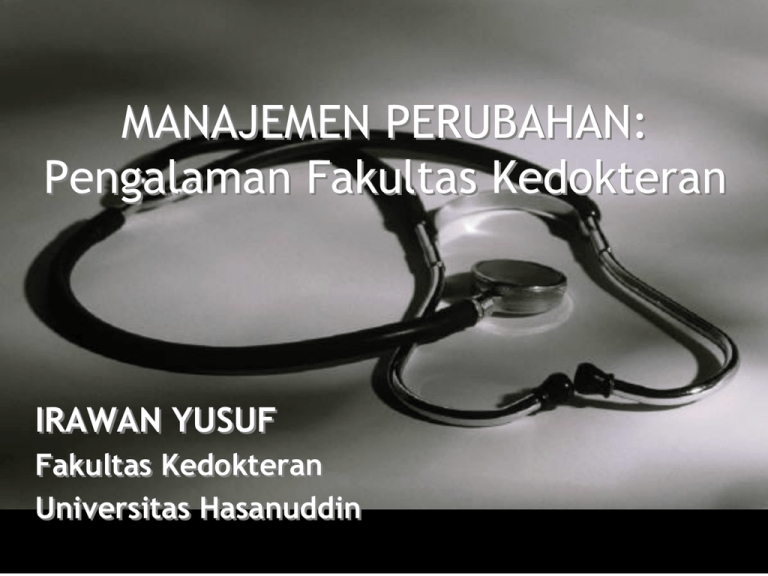
MANAJEMEN PERUBAHAN: Pengalaman Fakultas Kedokteran IRAWAN YUSUF Fakultas Kedokteran Universitas Hasanuddin PENDAHULUAN MENGAPA BERUBAH???? Perubahan kebutuhan masyarakat Kompetisi yang semakin ketat Globalisasi Perubahan kebijakan pemerintah Sisdiknas, BHP, quality-assurance) Kemajuan teknologi komunikasi informasi (UU dan PENDAHULUAN GOOD UNIVERSITY TEACH, UNIVERSITY TRANSFORM: GREAT Knowledge to product Human resource to human capital Imagination to reality GOOD UNIVERSITY PRODUCE GRADUATES, GREAT UNIVERSITY PRODUCE LEADERS Sulit berubah better PRESENT PAST upper FUTURE “GAP” lower harmfull The DELTA GAP’s Theory of CHANGE Ikaputra et.al, Unistaff summer school Unisattt Training, 2005 MANAJEMEN PERUBAHAN PROSES PERUBAHAN KONDISI SAAT INI Established equilibrium that continues indefinitely until something disrupts it MASA TRANSISI • Low stability • High emotional stress • High (often undirected) energy • Control becomes major issue Stability • Past patterns of behavior become highly valued Feeling of security KONDISI YANG DIHARAPKAN • Conflict increases • NEW VISION MANAJEMEN PERUBAHAN & TRANSISI (WORKING ON THE GAP) 1. EXPLORING Involving people as many as possible to have : • • Sharing vision Agreed upon SWOT feeling 2. SYSTEMIZING the Process: • • Keep people connected to the change process To create a space to express the positive and negative 3. VENTURING • • • Analizing the gap Anticipating resistance and gaining the commitment Providing opportunities for innovation and creativity Pilot and implementation 4. INTEGRATING • • • • Evaluate the changing process Expand successful process Review the pilot and implementation Institutionalized the approach RESISTENSI TERHADAP PERUBAHAN Mengapa resisten terhadap perubahan? Self interest Psychological impact Redistributive factor Destabilisation effect Culture incompatibility RESISTENSI TERHADAP PERUBAHAN Bagaimana perubahan? Status sikap resisten quo Filtering of information Maladaptive defence mechanisms Negative personal construct terhadap I WANT (+) I GET (+) I DON’T GET (-) I DON’T WANT (-) POWERFUL MAN VICTIM LOOSER SUCCESSFUL RESISTER Resistance is a self-regulating mechanism which • Keeps us from getting hurt • Keeps us from doing things not in our best interest • Keeps us from taking on too much RESISTENSI MERUPAKAN ASET ORGANISASI Resistensi menunjukkan komitmen Resistensi menyediakan informasi baru Resistensi menghasilkan enerji Resistensi menimbulkan rasa aman organisasi Tekanan x Visi x Rencana Transisi Perubahan = >1 Resistensi Mempersiapkan perubahan…. S hared vision U nderstand the organization C ultural alignment C ommunication E xperienced help where necessary S trong leadership S takeholder involvement PENDEKATAN UNTUK MENGATASI RESISTENSI Systemic Approach Top-down Bottom-up Transformational intelligence Approach Motivational intelligence (MQ) Process intelligence (PQ) Relational intelligence Creative intelligence Systemic Approach INDIVIDUAL SOCIAL TECHNOLOGICAL DEPARTMENT STRUCTURAL ORGANISATION POLITICAL TOP DOWN BOTTOM UP TRANSFORMATIONAL INTELLIGENCE APPROACH CQ CQ RQ PQ MQ CQ Methods for dealing with resistance to change Approach Commonly used in situation Advantages Drawbacks Education +communication Where there is a Once persuaded, Can be very timelack of people will often consuming if information or help with the lots of people inaccurate implementation are involved. information and of the change. analysis Participation + involvement People who participate Where the initiatiors Can be very timewill be committed to does not have all consuming if implementing change, the information participators and any relevant they need to design an information they design the change, inappropriate have will be and where others changes integrated into the have considerable change plan. power to resist. Methods for dealing with resistance to change`(Con.) Approach Commonly used in situation Advantages Drawbacks Facilitation + support Where people are resisting because of adjustment problems. No other approach Can be time works as well with consuming, adjustment problems expensive and still fail. Negotiation + agreement Where someone or some group will clearly lose out in a change and where that group that has considerable power to resist. Sometimes it is a relatively easy way to avoid major resistance. Can be too expensive in many cases if alerts others to negotiate for compliance. PENGALAMAN YANG DAPAT DIPETIK Change is learning, and learning is change Individual learning and organizational learning are inextricably link There are far more options for improvement or innovation than there is time or resources to address them Change is not an event but is a complex and subjective learning/unlearning process for all concerned The most successful changes are the result of team effort PENGALAMAN YANG DAPAT DIPETIK The change process is cyclical, not linear Change does not just happen – it must be lead Change is a mix of external forces and individual action We must look outside as well as inside for viable change ideas and solutions. THANK YOU
